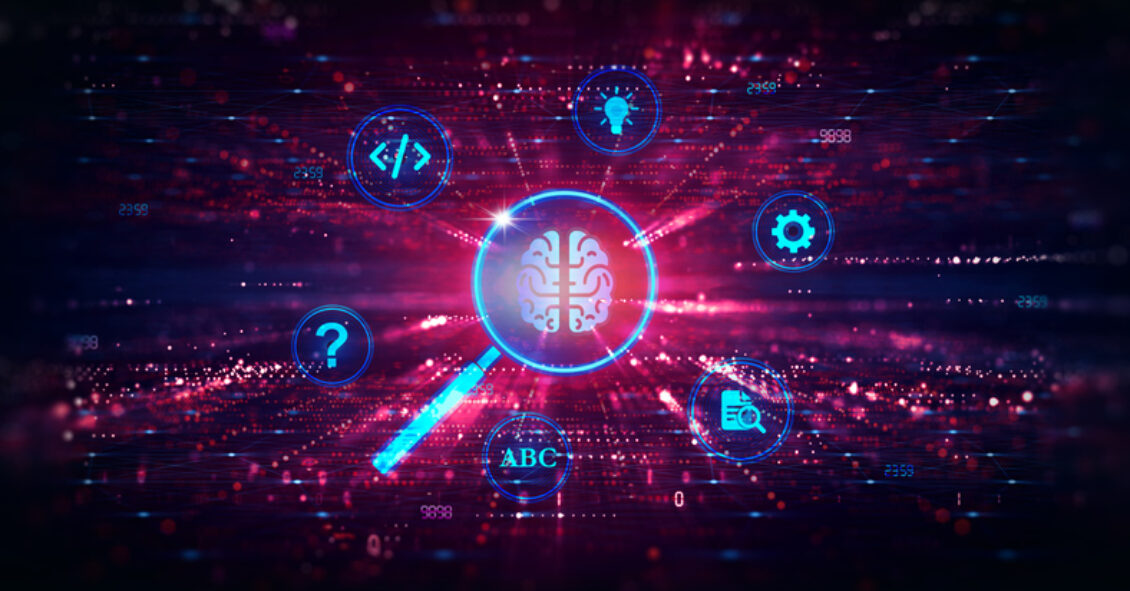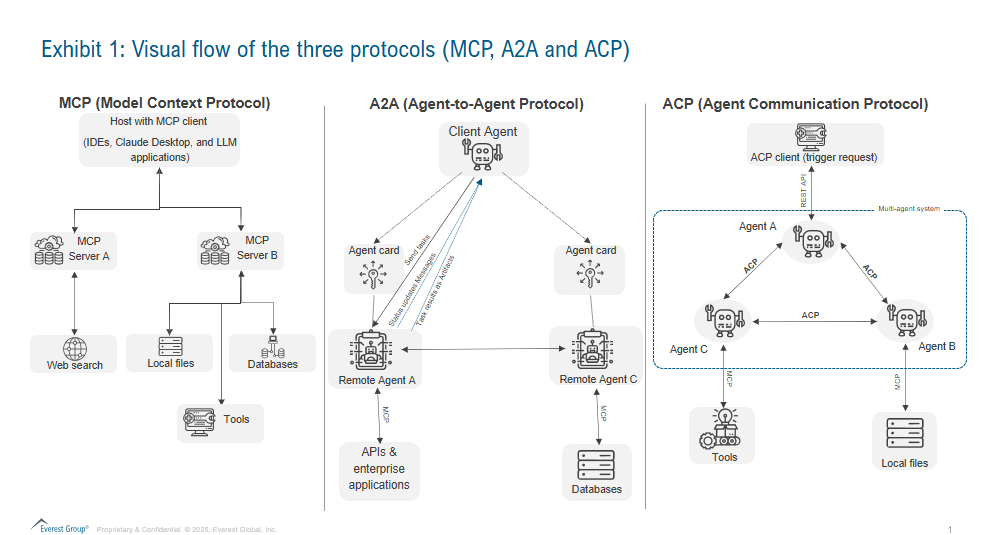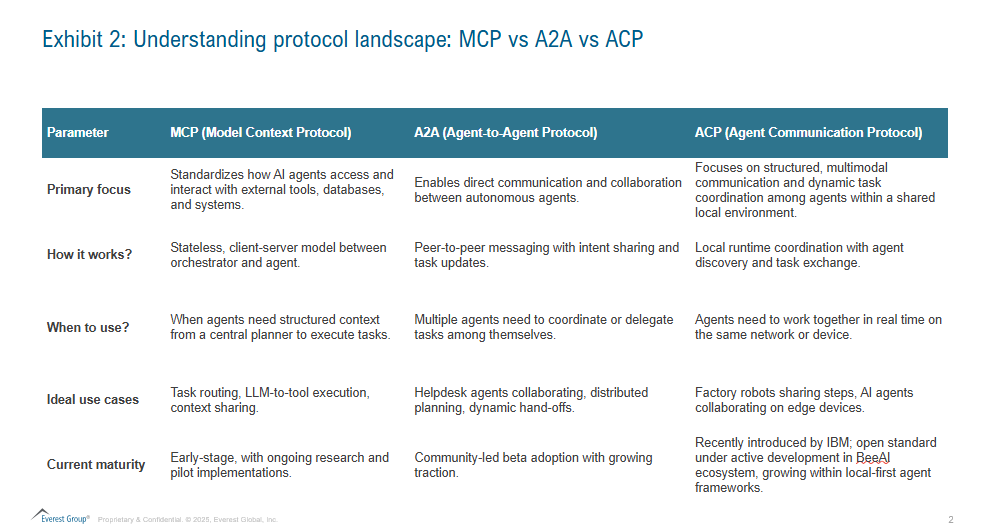
Why do protocols for AI agents matter now?
The rise of Agentic AI marks a turning point in enterprise automation. Traditional automation technologies relied on predefined rules which worked well for static tasks, but struggled with ambiguity, exceptions, or shifting goals. Agentic AI introduces autonomous software entities called AI agents which can set goals, interpret context, and act independently. These agents must function not just as tools, but as collaborators that coordinate with humans and other agents across platforms to complete complex tasks, while adapting to real-world variability.
To operate effectively, agents require a standardized way to communicate, whether sharing context, invoking tools, or delegating tasks. This is where agent protocols become really essential. Agent protocols define how agents initiate conversations, structure requests, and interact with other agents, tools, systems and humans, while maintaining shared context.
While REST APIs have served enterprise systems well, they fall short in supporting the context-rich, adaptive workflows that Agentic AI demands. Agent protocols are expected to fill this gap, avoid agent fragmentation and enable scalability. Just like Hypertext Transfer Protocol (HTTP) enabled the web by standardizing communication between browsers and servers, agent protocols could serve as the foundation for the agentic internet, enabling scalable, secure, and reliable collaboration between autonomous agents.
Reach out to discuss this topic in depth.
The protocol landscape
As enterprises begin to embrace the agent protocols for multi-agent collaboration, the next question is what options exist in the market today. Much like the early stages of the internet, the agent protocol landscape is still in formation with rapidly evolving, loosely coordinated, and competing ideas.
Today’s developments fall into three broad categories:
- Proprietary protocols or mechanisms from providers like OpenAI, LangChain, and AutoGPT are designed to support their internal agent ecosystems. OpenAI’s Function Calling lets Large Language Models (LLMs) trigger external tools, LangChain’s LCEL structures composable toolchains, and AutoGPT’s Planning APIs break goals into multi-step tasks. While effective within their own platforms, these approaches are typically closed and limit interoperability.
- Open community protocols, including Anthropic’s Model Context Protocol (MCP), Google’s Agent-to-Agent Protocol (A2A), and IBM’s Agent Communication Protocol (ACP), aim to establish provider-neutral standards for interoperability and collaboration. These efforts focus on scalable, secure communication across diverse agent frameworks and platforms.
- Specialized research frameworks, such as WebAgents, CAMEL, and AutoGen explore advanced use cases like web navigation, goal negotiation, and agent dialogue. While not formal protocols, they offer early design patterns that may shape future standards.
Rather than signaling fragmentation, this differentiation reflects functional specialization across the agentic stack. Similar to how protocols like HTTP and OAuth coexist in the internet ecosystem, the emergence of multiple agent protocols points to a layered architecture taking shape.
Deep dive into MCP, A2A, and ACP
As the agent ecosystem matures, a set of open community protocols, MCP, A2A, and ACP are emerging as foundational standards for structured, scalable communication across agent workflows. Unlike proprietary approaches locked within individual platforms, these protocols are designed for broader interoperability and ecosystem adoption. Each serves a different layer in the agent stack and introduces distinct architectural roles and capabilities.
Exhibit 1 shows the visual flow of the three protocols.
We will deep dive below into the 3 protocols to understand them better.

Model Context Protocol (MCP)
Introduced by Anthropic, MCP standardizes how AI agents connect with tools, databases, and systems in stateless environments. It enables contextual data transfer, such as user goals, memory, and task parameters, to execution agents without persistent sessions. Architecturally, MCP follows a client-server model, where the MCP Host sends task context to an MCP Server (agent or tool endpoint). MCP is transport-agnostic (HTTP, gRPC, WebSockets) and stateless, supporting loosely coupled agents ideal for cloud-native, distributed ecosystems. Unlike traditional one-to-one API integrations, MCP provides a reusable interface for connecting agents with tools at scale. Key capabilities include:
- Standardized context packaging for routing task-specific data
- Parallel tool execution without shared state
- Tool schema publishing for orchestrator-agent interoperability
MCP sits at the execution layer and enables task-specific information flow between the decision logic and execution modules in an agentic system.
Agent-to-Agent protocol (A2A)
Developed as part of Google’s agentic research, A2A defines how autonomous agents interact directly with one another. It addresses the coordination layer of the stack, enabling agents to share intents, delegate subtasks, and track task outcomes and synchronize progress. Unlike traditional workflows that rely on a central orchestrator, A2A allows agents to communicate peer-to-peer, each acting as both sender and receiver, maintaining its own logic and memory. The protocol supports:
- Goal propagation and refinement across agents
- Peer hand-off, where one agent offloads part of its workload to a more capable peer
- Asynchronous task tracking to allow coordination without tight coupling
- Structured messaging (text, data, files) for richer collaboration
- Task lifecycle management with standard states (e.g., submitted, working, input-required, completed), making it easier to coordinate even long-running tasks
Each agent publishes an “Agent Card” (JSON) describing its capabilities and endpoints, enabling dynamic discovery and cross-platform interoperability.
A2A is especially useful in open, cross-platform settings where agents need to negotiate or collaborate without prior knowledge of each other’s capabilities. Its compatibility with existing web standards like HTTP and JSON makes it easy to adopt within current enterprise environments. Google has collaborated with 100 partners on A2A, signaling development of a strong protocol ecosystem.
Agent Communication Protocol (ACP)
Developed by IBM Research as part of the BeeAI platform, ACP is an open standard designed to facilitate seamless communication among AI agents within a shared local environment. Building upon Anthropic’s Model MCP, ACP introduces capabilities such as dynamic agent discovery, task delegation, and improved agent-to-agent operability.
ACP supports dynamic agent discovery, meaning agents can register their capabilities with a local ACP runtime and receive tasks delegated from other agents in the same environment. It maintains structured messaging using a defined schema and supports:
- Task specification exchange, with metadata, traceability, and local constraints
- Agent registration and lookup, avoiding global discovery and reducing latency
- Multimodal message handling, such as text, image, and tool invocation payloads
ACP operates at the coordination and communication layer but is specialized for controlled environments where latency, reliability, and shared context are critical, such as manufacturing floors, autonomous vehicles, or localized enterprise deployments.
Our view: Each protocol aligns with a distinct interaction model. A2A supports agent-to-agent collaboration, MCP facilitates task execution through agent-to-orchestrator communication, and ACP enables structured communication and task coordination among agents operating within a shared local environment.
While not directly comparable, these protocols often complement each other. MCP is seeing broader early adoption, especially in an orchestrated, cloud -native environment. A2A is gaining traction for open, cross-platform agent networks, though its success depends on continued ecosystem development. ACP remains early-stage but is well-suited for edge and real-time environments.
Ultimately, the choice depends on context. Enterprises should align protocol use with their architecture – centralized (MCP), collaborative (A2A), or local-first (ACP). Their collective evolution is likely to shape the architecture of enterprise-scale agentic ecosystems in the years ahead.
Exhibit 2 compares the three protocols across key parameters such as focus area, deployment model, and ideal use cases to help navigate where each fits best.

What lies ahead?
Agent protocols enable communication between agents, systems, and AI-powered tools. As adoption grows, these protocols could follow one of three arcs. The first is a convergence scenario, where the industry agrees on a single open standard, similar to how HTTP unified web traffic. If that happens, enterprises enjoy plug-and-play compatibility and a large marketplace of ready-made agents. A second and more likely path is layered coexistence. In this scenario, ACP takes care of a secure start-up and local orchestration, MCP helps move context/information between AI tools and execution agents, and A2A allows specialists to hand tasks back and forth. Development tools would hide most of the complexity, so teams can focus on the workflow rather than the wire format beneath it. The third possibility is a protocol mesh. Vendors might keep evolving their own dialects, forcing organizations to use gateways or adapters that translate messages in real time. This offers flexibility and protects previous investments, but it also adds latency and raises governance overhead.
Whichever path wins out, multi-protocol fluency will matter. Engineering teams should build swappable layers, track open-source progress, and pilot small projects that combine two or three protocols today. That way, any eventual consolidation is an advantage, not a rewrite. Protocols rarely capture headlines, yet they will determine how smoothly, securely, and intelligently autonomous agents scale across the enterprise.
If you found this blog interesting, check out our How To Achieve The Promise Of Generative AI | Blog – Everest Group, which delves deeper into another topic regarding AI.
If you have any questions or want to discuss the evolution of AI in more depth, please contact Ruchin Dwivedi ([email protected]), Santhosh Kumar ([email protected]), and Vaibhav Bansal ([email protected]).











